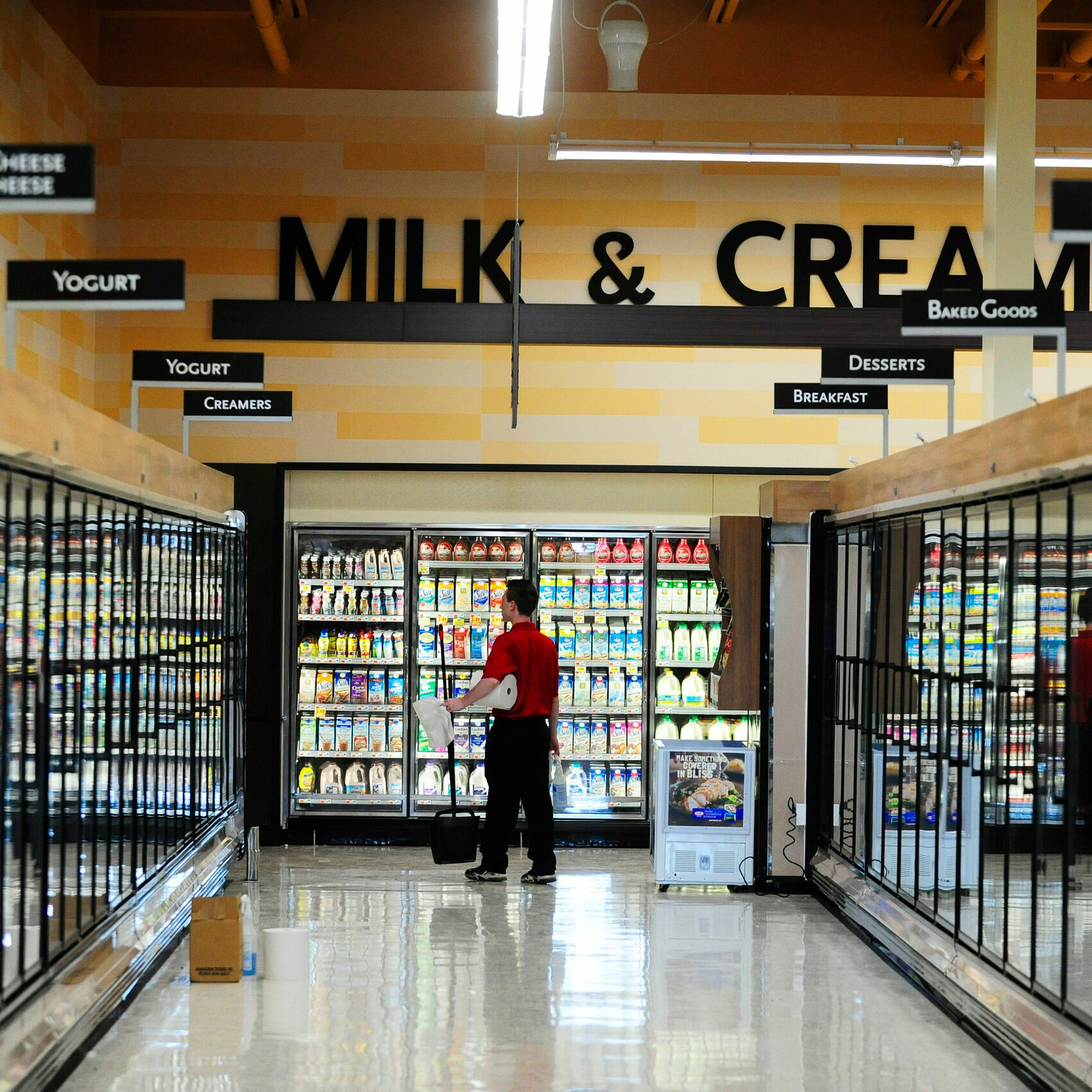There are two practical explanations—and one sneaky one

The Real Reasons Why Milk and Eggs Are Sold in the Back of a Grocery Store

You run to the supermarket for a gallon of milk … but have to trek to the way back of the store to grab it. It’s annoying, to say the least—even more so when you forget an item in that section and have to run back there again before checking out. You know your grocery store isn’t trying to help you hit your daily steps goal, so what’s going on?
To find out, we went straight to grocery insiders. While it may seem random, there’s a method to the milk-in-the-back madness (just as there’s a reason for the gust of cold air when you walk into a grocery store). Here’s why essentials like your 2% and eggs are almost always at the back of the supermarket.
Get Reader’s Digest’s Read Up newsletter for more interesting facts, humor, cleaning, travel and tech all week long.
Why are milk and eggs sold in the back of the grocery store?

If only the milk and eggs could be in a case by the front door, so you could grab that one thing and jet! But these staples aren’t on the far wall to make your day harder. Instead, they are stored in back for these good (and surprising!) reasons:
It allows for efficient cooling
You’ve probably noticed the milk, eggs, produce and meat are often on the (extra chilly) perimeter. There’s a logical explanation, according to Benjamin Lorr, author of The Secret Life of Groceries: The Dark Miracle of the American Supermarket: Cooling a giant supermarket is expensive, and this is an efficient way to do it.
“Because grocery is such a low-margin business—stores think a lot about how to conserve money to keep their edge,” he says. “This is the real reason the eggs and milk are in the back. Not because of some conspiracy where grocery stores want to drag you through the whole store just to get milk but because it is easier and cheaper to keep the condenser lines that cool the cases near the walls.”
It’s all about maintaining a healthy bottom line and keeping electricity costs and overhead down, adds retail expert Ryan Anderson, the president of Markiserv and a veteran of the consumer retail and government commissary industries. This positioning also helps the store retain cold air by the fresh stuff, so it doesn’t leak out as people go in and out of the store.
It keeps cold air from escaping that aisle
You’re probably wondering, Are grocery stores trying to drive us out faster with the cold temps in the milk aisle? More like the opposite: Uncomfortably cold temperatures encourage us to spend more, according to a study published in the Journal of the Association for Consumer Research. Among the findings? When we’re cold, we are more likely to make emotion-based decisions. That means if we’re feeling uncomfortable, we might be more inclined to take home a big box of Oreos, juicy organic fruit or a nice porterhouse steak.
It encourages impulse buys
By burying that carton of eggs and jug of milk all the way in the back, supermarkets ensure you walk by all the yummy things you don’t need—but might just grab on impulse. “Staples like milk and eggs are in the back because they’re high-demand items, and placing them there naturally leads shoppers past other products they might need—or didn’t realize they wanted until they saw them,” says grocery marketing veteran Tyler Renaghan, vice president of grocery at Upside, a grocery and fuel app.
This tactic isn’t just to benefit your local Piggy Wiggly or Whole Foods, though—supermarkets also want to make sure we don’t forget anything we need. “It’s not about tricking anyone, just about creating a shopping experience that works for both customers and the store,” Renaghan says.
It helps you get better service
The milk-in-back blueprint makes it simpler for the grocery store staff to keep that aisle full of fresh food. “Placing dairy near the back makes logistics easier—those refrigerated items need constant restocking, and this setup helps store teams work efficiently without disrupting the aisles,” Renaghan notes.
There’s another upside for us shoppers: Renaghan explains that by keeping the fresh basics—veggies, fresh-baked baguettes, meat, cold cuts, eggs—along the perimeter, stores “draw you in and help you plan meals.” Nice! Now if only they could cook the meals for us too.
About the experts
|
Why trust us
At Reader’s Digest, we’re committed to producing high-quality content by writers with expertise and experience in their field in consultation with relevant, qualified experts. We rely on reputable primary sources, including government and professional organizations and academic institutions as well as our writers’ personal experiences where appropriate. We verify all facts and data, back them with credible sourcing and revisit them over time to ensure they remain accurate and up to date. Read more about our team, our contributors and our editorial policies.
Sources:
- Benjamin Lorr, author of The Secret Life of Groceries: The Dark Miracle of the American Supermarket; email interview, Feb. 24, 2025
- Ryan Anderson, president of Markiserv and a veteran of the consumer retail and government commissary industries; email interview, March 6, 2025
- Tyler Renaghan, vice president of grocery at Upside in Chicago; email interview, March 5, 2025
- Journal of the Association for Consumer Research: “Warm Hearts and Cool Heads: Uncomfortable Temperature Influences Reliance on Affect in Decision-Making”























